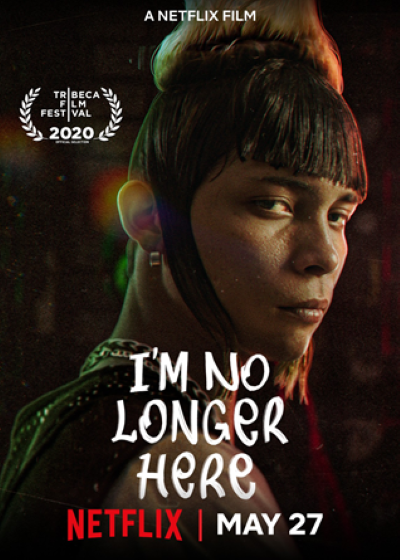7.9.2021 Susy’s review of “Ya No Estoy Aquí” (2019)
7.9.2021 Susy's review of "Ya No Estoy Aquí" (2019) Heading link

“No entiendo” (I don’t understand) – these are the words repeated by Ulises (played by Juan Daniel Garcia), a seventeen year old from Monterrey, Mexico, throughout the coming-of-age drama, “Ya No Estoy Aquí” (I’m No Longer Here ) by Mexican director Fernando Frías de la Parra. In this 2019 movie, Ulises follows in the steps of many before him; a risky journey across the Mexican American border to survive, except this time, Ulises isn’t searching for a better life, rather he’s running away from a life of violence.
“I’m No Longer Here” shows a series of flashbacks and flashforwards of Ulises before and after a cartel chases him out of Monterrey. The film also emphasizes the importance of the Kolombia movement in Monterrey, a genre of music similar to Cumbia, but with a slower tempo. Kolombia is a lifestyle for the residents of Monterrey; the men’s oversized clothing and distinctive haircuts (dyed, slicked down on the sides and shaved in the back) mixed with the women’s tightly fitted attire, ankle jeans, the bandanas and the converse, make up the interesting style of the “Cholombianos,” the name of the Kolombia listening community. This unique community and its music saves Ulises as he’s forced to adapt to a new lifestyle, culture and language in Queens, New York.
Ulises’ repeated phrase, “No entiendo,” naturally portrays his language barrier and culture shock in New York, but it’s more than that. After sleepless nights, no income, and even a confrontation with police, Ulises doesn’t understand how he got to such a low point in life, where he’s forced to abandon his family and fend for himself as people look down upon him for his appearance and language. However, his emotions shift once he turns on his mp3 player, plugs in his headphones, and Kolombia pours into his ears. When Ulises closes his eyes and begins to concentrate on his footwork, images of his life in Monterrey take over the screen, and the audience watches the juxtaposition of a once content Ulises dancing, singing, and laughing with “Los Terkos” (his gang) as they bond through their love for each other and for Kolombia.
This film also touches upon themes of solidarity between interethnic groups. In New York, Ulysses befriends Lin, a sixteen year old Chinese -American girl that hides him in her grandpa’s shed on the roof of his convenience store. Despite their language differences, they both manage to communicate through gestures, their limited vocabulary, and eventually through the power of music.
In the end, although the action is a bit slow at first, viewers eventually learn to appreciate the overlooked cultural aspects of Monterrey, Mexico.
As a Mexican American whose parents come from Zacatecas and Aguascalientes, I have a completely different experience of life in Mexico. With that said, it was eye- opening to witness another side of the country. In some parts of Monterrey, people seek comfort in the arms of gangs because it’s the only family they have. Villages in Monterrey have flaws, just like other places, but violence and poverty don’t define or separate them; their passion for Kolombia music unites them as one.
Now available on U.S. Netflix in Spanish with English subtitles. You can add Spanish subtitles to practice your listening and reading skills in Spanish or change the subtitles to English. Side note : the English subtitles don’t always translate correctly, so I suggest switching to Spanish subtitles so you can see the direct spelling of the new vocabulary and slang terms.
-Susy